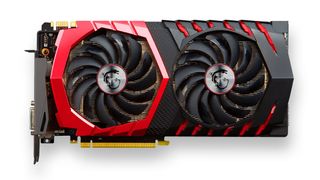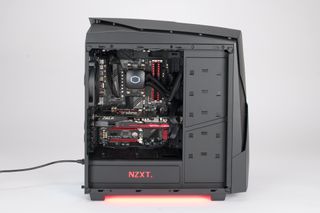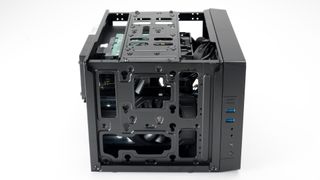What you need to know about GPU coolers
GeForce or Radeon, cooling designs matter.

AIB customized designs (a.k.a. “custom coolers”)
PC Gamer's got your back
If you’re in the business of manufacturing and selling graphics cards, it isn’t enough to just copy and paste the specs given by Nvidia or AMD. No sir, you have to differentiate yourself. That’s exactly what companies like Asus, MSI, EVGA and Gigabyte do with their custom designs.
For lack of a better term, I’m going to refer to the cooling designs by add-in board (AIB) partners as “custom coolers.” If you’re not yet sure what I’m talking about, you’ve probably seen these designs while shopping. They’re pretty standard for each brand. Asus’s Strix, EVGA’s ACX, MSI’s Twin Frozr, Sapphire’s Nitro, and Gigabyte’s WindForce lines are all examples cards that employ what I like to call “custom coolers.” All of these companies tout their respective cards as offering better performance, factory overclocks, and lower GPU core temps to boot. And for the most part, they’re usually fairly accurate.
What’s often left out of the advertising is just how these coolers achieve lower temperatures. Instead of pushing air down a channel and out of your case like reference blowers do, custom coolers typically push air from the face of the card into a custom-made heatsink. Heatsink designs vary, but many of these coolers feature advanced features like heatpipes, just like you’d find on aftermarket CPU coolers like Cooler Master’s Hyper 212 Evo.
The thing is, once air is forced into that fancy heatsink, it usually has nowhere else to go. The air is usually simply dumped out the sides of the card into the case. This is efficient, since it evacuates the hot air from the card much faster than a blower usually does. The problem is what happens to the air when the card’s done with it.

Without a system designed for high airflow, I’ve noticed this air tends to sit near the card and inside the case. This heightened ambient temperature makes it progressively harder for your CPU and video card to cool themselves. Unless you have a battery of fans moving air in and out of your case at a reasonable rate, you may find your CPU and GPU temperatures climbing into dangerous territory during an extended gaming session.
What this means is that if you’re planning on going with a custom cooler model video card, you should plan on having good airflow. This is doubly important if you’ve got an air-cooled CPU, and if you’re trying to build a mini-ITX rig it’s a critical consideration. Just like custom cooler graphics cards, air-cooled CPU coolers dump their waste heat directly into the case. That warm air will contribute to higher core temperatures on both your CPU and GPU, since air coolers won’t operate as efficiently with a higher ambient temperature. Fluids move from areas of high pressure to low pressure in search of equilibrium, and heat likewise moves from a hotter medium to a colder one. (Scientifically, “cold” is just a term to describe the lack of heat.)
If you’re determined to get a custom cooler video card and adding a ton of fans isn’t possible, consider an all-in-one (or “AIO”) liquid cooler if you’ll be using a CPU with a TDP over 85W (basically K-model Intel CPUs and AMD chips). You won’t necessarily need the biggest one (like the 280mm NZXT Kraken), but even a modest liquid cooling setup can go a long way in reducing ambient temps in situations where you’ll have reduced airflow. Even then, I’d recommend at least one (120mm or larger) intake or exhaust fan at minimum.
There’s another thing to consider when purchasing a custom cooler design: form. Custom cooler graphics cards come in a myriad of shapes, with all manner of heat pipes and cowlings protruding from the cards, depending on the manufacturer. Some of these features perform a function, and other may be purely decorative.

Custom cooler designs often wildly alter the overall size of the card. The Asus R9 390 Strix is huge. Sure the card itself is big, but the cooler’s features make it even bigger. While custom designs tend to be larger than the reference blowers are, they can be significantly smaller too. If you’re looking for a card for a small form factor build, there’s a good chance you’ll have to look for a short card, which will generally measure seven inches or less. Two great examples of this class of card are the EVGA GTX 960 4GB 1962-KR model and the Asus GTX 970 DCMOC. AMD’s Radeon R9 Nano is a reference card that fits into the small form factor class, but it’s an more of an exception than a rule for reference cards, and it’s not a blower so it can cause a lot of heat buildup in smaller systems.
Size and heatsink design aren’t the only thing you’ll notice about custom cooler cards. Add-in board partners have begun adding backplates to their higher-end offerings too. While a metal backplate is aesthetically pleasing, it also serves a purpose. Large cards can put an enormous amount of strain on your motherboard’s PCIe connectors (which is why you should always secure your graphics cards with slot screws). The PCB that makes up the base of the card can sag under the weight of a heavy heatsink. This effect is compounded if the PC is moved around a lot. A backplate can help alleviate these concerns. If you’ve got your eyes on a card that doesn’t have a backplate, you can always buy an aftermarket plate that you can affix to the card yourself.
Finally, I have to mention one more thing about custom cards: clock speeds. Custom cooler cards will often come with a factory overclock that will be active by default. If you’re not the type to go testing warranties, that’s great news. However, the factory cards often only come with factory overclocks that are well below the levels that can be achieved by the GPU. You’ll often pay a little more for these cards too. If you’re planning on overclocking these cards even more, be sure to utilize more aggressive fan curves and maintain good airflow to keep the GPU happy.
Pros:
- Custom designs may come with factory overclocks
- Custom designs often look cooler than stock GPUs
- May come in larger or smaller form factors than the reference model cards
- High-end models may come with backplates pre-installed
- Efficient paths for air wick heat away from heatsinks faster
Cons:
- Larger designs and oddly-shaped cowlings can prohibit the range of PC cases that you can use
- Often dump hot air into your case instead of pushing it out the rear, potentially requiring additional fans or a larger case
- Have historically cost more than reference models
- Not always the best choice for SLI/CF setups, due to dumping of hot air
- Factory overclocks may mean higher idle and load temperatures than reference models
Best suited for:
- Single-GPU builds with high airflow
- Single-GPU builds that use an AIO cooler for the CPU
- Small form factor builds that require cards under 8 inches
The biggest gaming news, reviews and hardware deals
Keep up to date with the most important stories and the best deals, as picked by the PC Gamer team.
Most Popular


